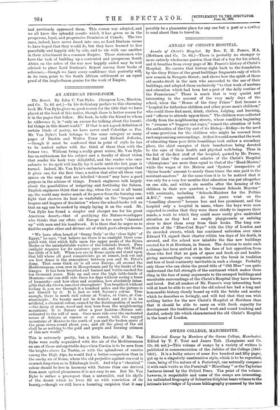ANNALS OF CHRIST'S HOSPITAL.
Annals of Christ's Hospital. By Rev. E. H. Pearce, M.A. (Methuen and Co. is. 6d.)—There is probably no stronger or more entirely wholesome passion than that of a boy for his school, and it breathes from every page of Mr. Pearce's history of Christ's Hospital. He carries that history right back to the foundation by the Grey Friars of the great buildings fragments only of which now remain in Newgate Street ; and shows how the spirit of those old monks dwelt in the men who succeeded to the use of their buildings, and adapted them exclusively " to that work of nurture and education which had been but a part of the daily routine of the Franciscans." There is much that is very quaint and interesting in the account of the very early days of the school, when the " House of the Grey Friars " first became a "hospital for fatherless children and other poore men's children," who could there find meat, drink, clothes, lodging, and learning, and " officers to attende uppon them." The children were collected chiefly from the neighbouring streets, whose condition beginning to "swarme wt' baggers and roges," roused the attention of both the authorities of the City and of its Bishop—Ridley—to the need of some provision for the children who might be rescued from such unpromising surroundings. At first it would seem that the work of educating these poor little foundlings took rather a secondary place, the chief energies of their benefactors being devoted to the care of their health and physical well-being. Thus in the list of the first staff of the hospital, quoted by Mr. Pearce, we find that "the combined salaries of the Christ's Hospital chirurgiones ' are more than equal to that of the ' Head-Master; while the wages of the Matron and Systers' irrespective of theire boorde' amount to nearly three times the sum paid to the assistant-masters." At the same time it is to be noticed that it was only for a very few months that education was put altogether on one side, and within six months after the housing of the children in their new quarters a " Gramer Scheele Mayster" with assistants, including " Schoole-Maisters for the Petties A.B.C.," were appointed. As the years went on the "foundling element" became less and less prominent, and the hospital only a hospital in name, where the boys were soon expected to realise that they were there chiefly to improve their minds, a work to which they could more easily give undivided attention as they had no ample playgrounds or enticing river to draw them away from their books. The long con- nection of the "Blue-Coat Boys" with the City of London and its crowded streets, which has continued unbroken ever since Edward VI. signed their charter within ten days of his death, is severed, and the school now inhabits the fine new buildings erected for it at Horsham, in Sussex. The decision to make such a change has been arrived at in the face of hot opposition from those who feel that no gain of space and fresh air and health. giving surroundings can compensate for the break in tradition and loss of local continuity inevitable in such a change. Probably only those who can claim the proud title of "Old Blue" can quite understand the full strength of the sentiment which makes them cling in the face of many arguments to the cramped buildings and unsuitable surroundings of the Christ's Hospital they have known and loved. But all readers of Mr. Pearce's very interesting book will at least be able to see that the old school has had a long and honourable history closely bound up with the bricks and mortar which he describes so lovingly, and will feel that they can wish nothing better for the new Christ's Hospital at Horsham than that it should be able to carry on with fresh capacity for development the traditions of hard work and sound teaching and dutiful, orderly life which characterised the old Christ's Hospital in the heart of London.


















































 Previous page
Previous page